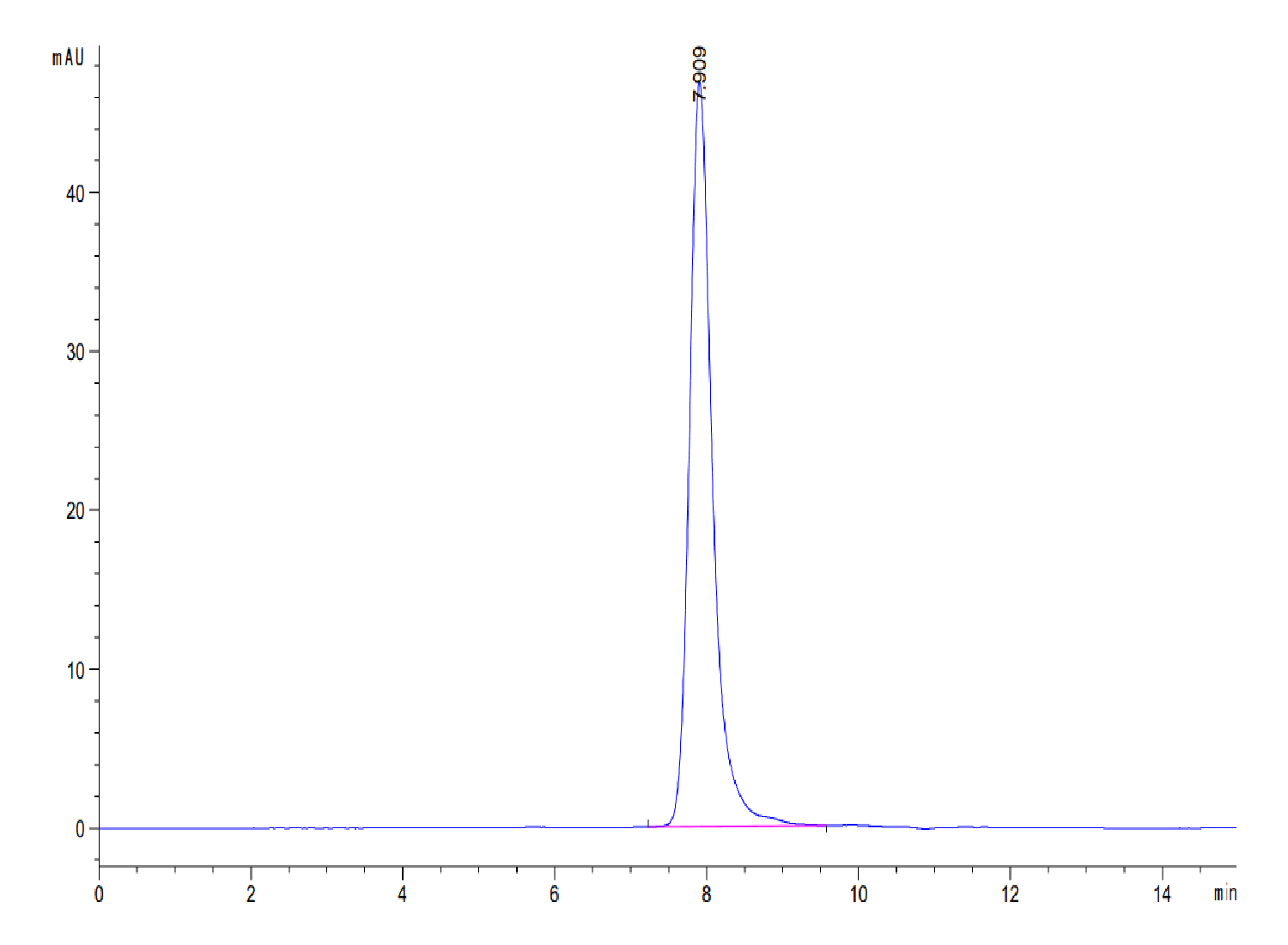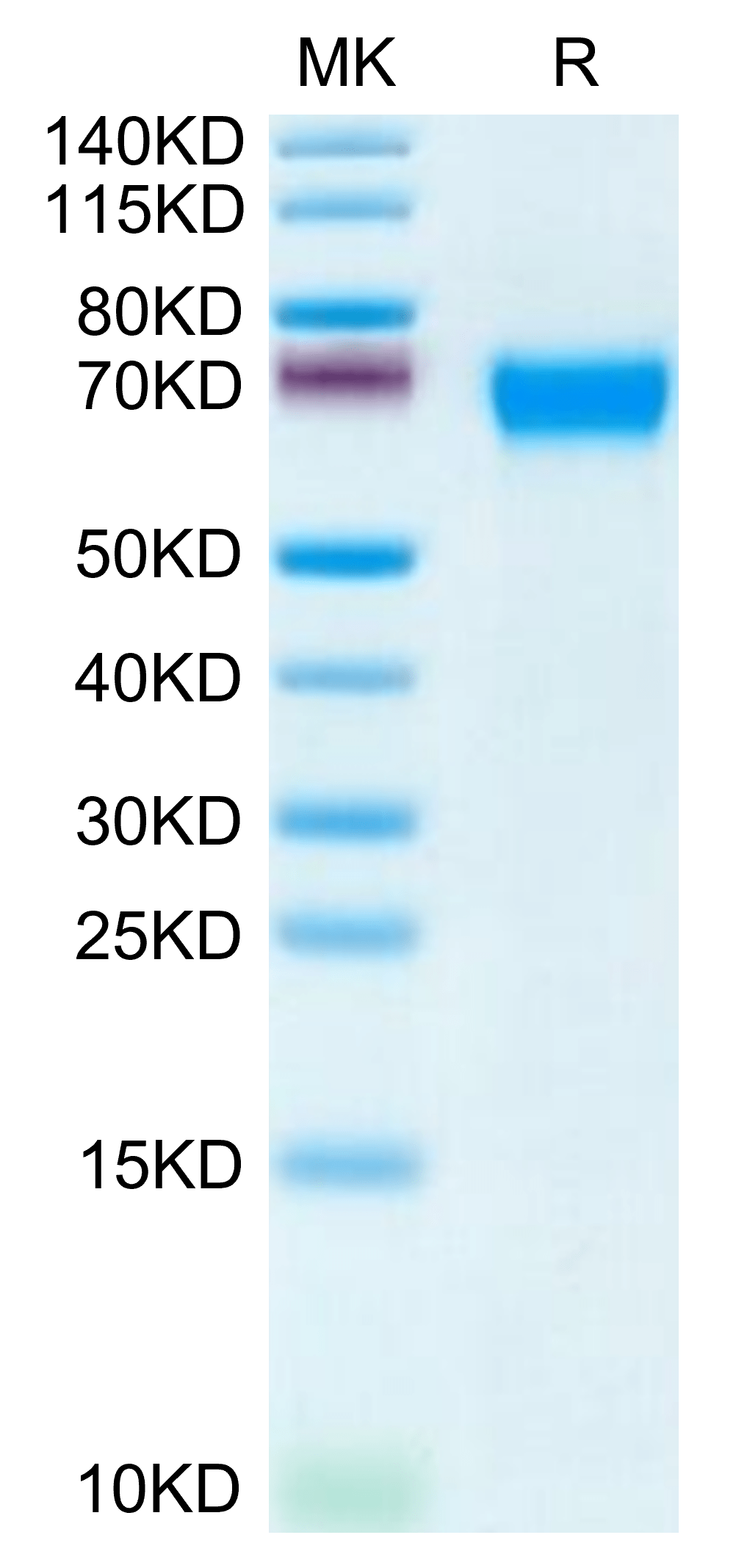| Weight | 1 lbs |
|---|---|
| Dimensions | 9 × 5 × 2 in |
| accession | P15529 |
| express system | HEK293 |
| product tag | C-His |
| purity | > 95% as determined by Tris-Bis PAGE;> 95% as determined by HPLC |
| background | CD46 was discovered in 1986 during a search for novel C3b-binding proteins. CD46 is expressed ubiquitously and functions as a co-factor in the factor I-mediated proteolytic cleavage of C3b and C4b. Its vital role in preventing complement deposition on host tissue is underpinned by the fact that deficiency of CD46 is a predisposing factor for numerous disease conditions arising from complement-mediated 'self-attack'. |
| molecular weight | The protein has a predicted MW of 35.4 kDa. Due to glycosylation, the protein migrates to 60-70 kDa based on Tris-Bis PAGE result. |
| available size | 100 µg, 500 µg |
| endotoxin | Less than 1EU per μg by the LAL method. |
Human CD46 Protein 3858
$285.00 – $950.00
Summary
- Expression: HEK293
- Functional: Yes (ELISA)
- Amino Acid Range: Cys35-Asp343
Human CD46 Protein 3858
| protein |
|---|
| Size and concentration 100, 500µg and lyophilized |
| Form Lyophilized |
| Storage Instructions Valid for 12 months from date of receipt when stored at -80°C. Recommend to aliquot the protein into smaller quantities for optimal storage. Please minimize freeze-thaw cycles. |
| Storage buffer Shipped at ambient temperature. |
| Purity > 95% as determined by Tris-Bis PAGE |
| target relevance |
|---|
| CD46 was discovered in 1986 during a search for novel C3b-binding proteins. CD46 is expressed ubiquitously and functions as a co-factor in the factor I-mediated proteolytic cleavage of C3b and C4b. Its vital role in preventing complement deposition on host tissue is underpinned by the fact that deficiency of CD46 is a predisposing factor for numerous disease conditions arising from complement-mediated 'self-attack'. |
| Protein names Membrane cofactor protein (TLX) (Trophoblast leukocyte common antigen) (CD antigen CD46) |
| Gene names CD46,CD46 MCP MIC10 |
| Mass 43747Da |
| Function Acts as a cofactor for complement factor I, a serine protease which protects autologous cells against complement-mediated injury by cleaving C3b and C4b deposited on host tissue. May be involved in the fusion of the spermatozoa with the oocyte during fertilization. Also acts as a costimulatory factor for T-cells which induces the differentiation of CD4+ into T-regulatory 1 cells. T-regulatory 1 cells suppress immune responses by secreting interleukin-10, and therefore are thought to prevent autoimmunity.; (Microbial infection) A number of viral and bacterial pathogens seem to bind MCP in order to exploit its immune regulation property and directly induce an immunosuppressive phenotype in T-cells.; (Microbial infection) Acts as a receptor for Adenovirus subgroup B2 and Ad3.; (Microbial infection) Acts as a receptor for cultured Measles virus.; (Microbial infection) Acts as a receptor for Herpesvirus 6/HHV-6.; (Microbial infection) May act as a receptor for pathogenic bacteria Neisseria and Streptococcus pyogenes (PubMed:7708671, PubMed:9379894, PubMed:11260136, PubMed:11971006). |
| Subellular location Cytoplasmic vesicle, secretory vesicle, acrosome inner membrane ; Single-pass type I membrane protein. Note=Inner acrosomal membrane of spermatozoa. Internalized upon binding of Measles virus, Herpesvirus 6 or Neisseria gonorrhoeae, which results in an increased susceptibility of infected cells to complement-mediated injury. In cancer cells or cells infected by Neisseria, shedding leads to a soluble peptide. |
| Tissues Expressed by all cells except erythrocytes. |
| Structure Interacts with C3b (PubMed:3260937, PubMed:1717583). Interacts with C4b (PubMed:1717583). Interacts with moesin/MSN (PubMed:7884872).; (Microbial infection) Interacts with measles virus H protein.; (Microbial infection) Interacts with human herpesvirus 6 GH protein (PubMed:12663806, PubMed:12724329).; (Microbial infection) Interacts with human adenovirus B/D fiber protein (PubMed:12915534, PubMed:14566335, PubMed:15047806, PubMed:15078926, PubMed:15919905, PubMed:16254377).; (Microbial infection) Binds to Streptococcus pyogenes M protein and to type IV pili from Neisseria (PubMed:7708671, PubMed:9379894, PubMed:11260136, PubMed:11971006). |
| Post-translational modification N-glycosylated on Asn-83; Asn-114 and Asn-273 in most tissues, but probably less N-glycosylated in testis. N-glycosylation on Asn-114 and Asn-273 is required for cytoprotective function. N-glycosylation on Asn-114 is required for Measles virus binding. N-glycosylation on Asn-273 is required for Neisseria binding. N-glycosylation is not required for human adenovirus binding.; Extensively O-glycosylated in the Ser/Thr-rich domain. O-glycosylation is required for Neisseria binding but not for Measles virus or human adenovirus binding.; In epithelial cells, isoforms B/D/F/H/J/L/3 are phosphorylated by YES1 in response to infection by Neisseria gonorrhoeae; which promotes infectivity. In T-cells, these isoforms may be phosphorylated by LCK. |
| Domain TOPO_DOM 3 |
| Target Relevance information above includes information from UniProt accession: P15529 |
| The UniProt Consortium |
Data
Publications
Publications
| pmid | title | authors | citation |
|---|---|---|---|
| We haven't added any publications to our database yet. | |||
Protocols
| relevant to this product |
|---|
Documents
| # | ||
|---|---|---|
| Please enter your product and batch number here to retrieve product datasheet, SDS, and QC information. | ||

















